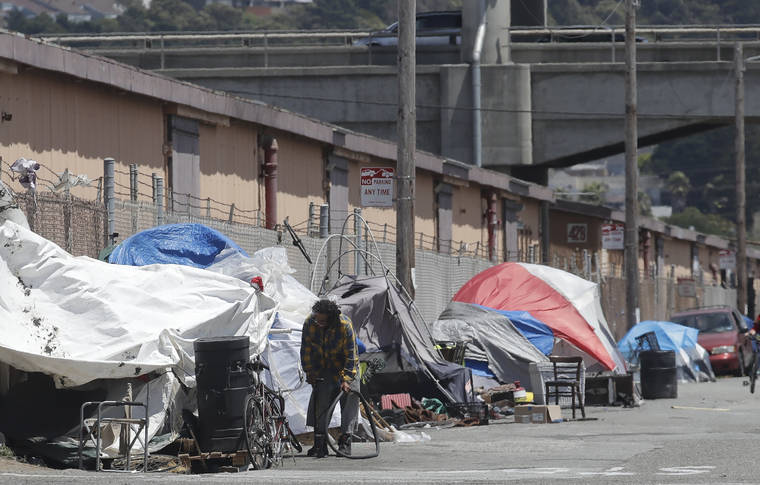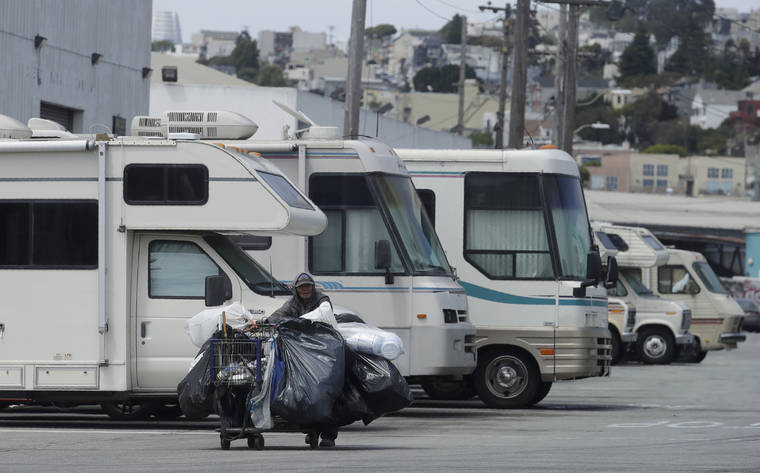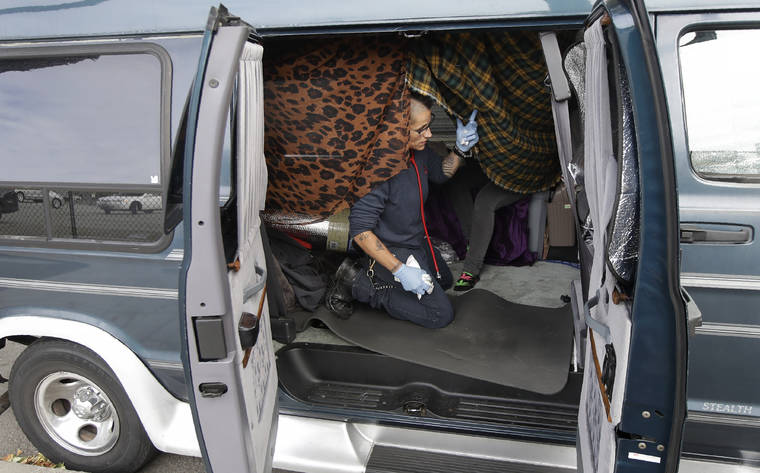More homeless people in San Francisco are living in RVs and other vehicles

ASSOCIATED PRESS / JUNE 27
A man holding a bicycle tire outside of a tent along a street in San Francisco. A federally mandated count of homeless in San Francisco increased 17% in two years, driven in part by a surge of people living in RVs and other vehicles.

ASSOCIATED PRESS / JUNE 27
A person pushing a cart past parked RVs along a street in San Francisco. A federally mandated count of homeless in San Francisco increased 17% in two years, driven in part by a surge of people living in RVs and other vehicles.

ASSOCIATED PRESS / JUNE 25
Shanna Couper Orona tending to her friend Jess (last name not given) in Jess’ parked van along a street in San Francisco. A federally mandated count of homeless in San Francisco increased 17% in two years, driven in part by a surge of people living in RVs and other vehicles.



SAN FRANCISCO >> Most homeless people in San Francisco sleep in parks and on sidewalks but a growing number are living out of their vehicles, helping fuel an overall 17% increase in homelessness in the last two years, according to a report released Friday.
San Francisco tallied about 8,000 homeless in its one-night count in January, when counties across the country conducted similar counts as required by the U.S. Department of Housing and Urban Development.
Other counties in California also saw double-digit increases, reflecting the state’s severe housing crunch. In May, Alameda County, which includes Oakland, reported a 43% increase over two years while last month Los Angeles County reported a year-to-year 12% jump to nearly 59,000 homeless, with more young adults, older people and families on the streets
The San Francisco report, released by the city’s Department of Homelessness & Supportive Housing, paints a picture of a city in crisis despite hundreds of millions of dollars spent every year to tackle the problem. Nearly 1,200 people were on the waiting list for shelter beds the week of the January count.
Officials say they can’t keep pace with the number of people who become homeless in a city where the median sales price of a house hovers at $1.4 million and median rent for a one-bedroom apartment is around $3,700. Nearly two-thirds of those surveyed said they had been living in a place they or their partner rented or owned, or with family or friends immediately prior to becoming homeless.
Homelessness continues to be associated with deep poverty, mental illness and addiction— tents and people sprawled out on sidewalks are all too visible. But people of higher income levels, including those who own cars, are also struggling, said Jeff Kositsky, the San Francisco agency’s director.
Don't miss out on what's happening!
Stay in touch with breaking news, as it happens, conveniently in your email inbox. It's FREE!
“I’m seeing people with decent RVs but with no place to live, and many of them have jobs,” he said. “It’s very concerning and it all indicates what everybody already knows in California: that we have a severe affordable housing shortage.”
San Francisco identified nearly 600 passenger vehicles, RVs or vans that appeared to be inhabited, according to the report.
RV living has more commonly been associated with Silicon Valley suburbs that are home to Apple, Facebook and Google, which have struggled with the dozens of RVs that line its streets. But San Francisco plans to open a “safe site” for vehicles by the end of the year. The city of Oakland opened a space for people living in their vehicles last month.
“It’s definitely a sign of the wealth gap and what’s happening in San Francisco,” said Supervisor Vallie Brown, adding that officials failed to build units for decades, “and then all of a sudden we became an economic engine where almost anyone who comes to this city can get a job but there’s no housing for people.”
Julio, a longtime gardener, said he bought an RV for $12,000 off Craigslist in late 2017, after conflicts with neighbors. Julio, 50, asked that his last name not be used because he does not want to jeopardize his business.
For more than a year, he parked around San Francisco State University, staying one step ahead of notices to move. About six months ago the family of four, including two teens, got a spot at the Candlestick RV Park, where they now have electricity and water.
“San Francisco is rich. They can definitely do a lot more, and I wish they could do something better,” he said. “There are a whole bunch of working people … I know for a fact there are more people like myself and my family out there, and they don’t deserve this.”
Kelley Cutler, an organizer with the Coalition on Homelessness in San Francisco, said it’s natural for people who have lost their homes to take to their cars. She wishes the city would stop towing RVs and clearing out tents, and focus instead on finding help for people sleeping in doorways.
“It’s the shuffling game around the city, but it’s not addressing the issue,” she said.
Shanna Orona, who goes by the name Couper, is a disabled former firefighter who has been living in a beat-up RV in the Mission District for about seven months. She lives with her cat, Maison, and moves it once a week for street-cleaning.
She has been homeless for about four years, after a divorce that left her without a condo to call home. She tends to other homeless people, treating cuts and changing bandages.
“We’re just like everyone else. The only difference between them and us, housies and us, is they have a roof over their head and we don’t, but we’re all San Francisco residents,” she said.
Homelessness isn’t necessarily growing in other parts of the country. Seattle’s King County reported an 8% decrease from last year to just over 11,000 and the Washington D.C. area counted 9,800 people, the lowest number recorded since 2001.
Kositsky, the homeless department director, remains optimistic, despite a population that is older, sicker and growing. San Francisco is adding shelter beds and he sees progress in housing veterans and youth— and the 17% increase was not as high as in other California counties.
San Francisco also conducts an expanded count that includes the number of homeless people in jails, hospitals and treatment centers on the same time. That number was 9,800, up from 7,499 in 2017, although part of that increase is due to improved counting, the report said.



